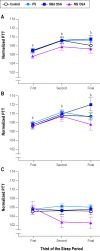Preschool children with obstructive sleep apnea: the beginnings of elevated blood pressure?
- PMID: 23904682
- PMCID: PMC3700719
- DOI: 10.5665/sleep.2890
Preschool children with obstructive sleep apnea: the beginnings of elevated blood pressure?
Abstract
Study objectives: In adults and older children, snoring and obstructive sleep apnea (OSA) are associated with elevated blood pressure (BP). However, BP has not been assessed in preschool children, the age of highest OSA prevalence. We aimed to assess overnight BP in preschool children with snoring and OSA using pulse transit time (PTT), an inverse continuous indicator of BP changes.
Design: Overnight polysomnography including PTT. Children were grouped according to their obstructive apnea-hypopnea index (OAHI); control (no snoring, with OAHI of one event or less per hour), primary snoring (OAHI one event or less per hour), mild OSA (OAHI greater than one event to five events per hour) and moderate-severe OSA (OAHI more than five events per hour).
Setting: Pediatric sleep laboratory.
Patients: There were 128 clinically referred children (aged 3-5 years) and 35 nonsnoring community control children.
Measurement and results: PTT was averaged for each 30-sec epoch of rapid eye movement (REM) or nonrapid eye movement (NREM) sleep and normalized to each child's mean wake PTT. PTT during NREM was significantly higher than during REM sleep in all groups (P < 0.001 for all). During REM sleep, the moderate-severe OSA group had significantly lower PTT than the mild and primary snoring groups (P < 0.05 for both). This difference persisted after removal of event-related PTT changes.
Conclusions: Moderate-severe OSA in preschool children has a significant effect on pulse transit time during REM sleep, indicating that these young children have a higher baseline BP during this state. We propose that the REM-related elevation in BP may be the first step toward development of daytime BP abnormalities. Given that increased BP during childhood predicts hypertension in adulthood, longitudinal studies are needed to determine the effect of resolution of snoring and/or OSA at this age.
Keywords: Blood pressure; children; obstructive sleep apnea; preschool; pulse transit time; snoring.
Figures




References
-
- Hamilton GS, Solin P, Naughton MT. Obstructive sleep apnoea and cardiovascular disease. Intern Med J. 2004;34:420–6. - PubMed
-
- Horne RS, Yang JS, Walter LM, et al. Elevated blood pressure during sleep and wake in children with sleep-disordered breathing. Pediatrics. 2011;128:e85–92. - PubMed
-
- Li AM, Au CT, Ho C, Fok TF, Wing YK. Blood pressure is elevated in children with primary snoring. J Pediatr. 2009;155:362–8. - PubMed
Publication types
MeSH terms
LinkOut - more resources
Full Text Sources
Other Literature Sources
Medical

